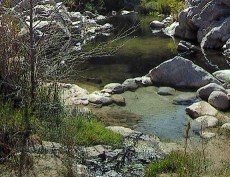Mature, non-native palm trees, such as these near the Volcano Pool, will stay in place until they die of natural causes.
NPS
DEATH VALLEY, CA – National Park Service (NPS) staff will host a public meeting on November 17, 2019 at 1:00pm to give an update about and discuss timelines for the recently completed Saline Valley Warm Springs Final Management Plan and Environmental Impact Statement. Saline Valley Warm Springs are located in a remote northwest corner of Death Valley National Park, 35 miles from the closest paved road. Recreational users developed soaking tubs and art installations starting in the 1950s. The site was managed by the Bureau of Land Management (BLM) until it was transferred to NPS by the California Desert Protection Act in 1994.
The NPS started working on a management plan for the site in 2012. Inyo County, the BLM, and the Timbisha Shoshone Tribe participated in the plan as cooperating agencies. Several organizations were heavily involved in providing comments, including the Saline Preservation Association and Recreation Aviation Foundation. There were opportunities for the public to provide feedback on the plan’s direction in 2012, 2014, and 2018. The NPS hosted 12 public meetings and received a total of 1,696 pieces of correspondence during these comment periods. The NPS made changes to the plan at every stage of the process reflecting the feedback received from the public, organizations, and agencies.
“Saline Valley is a very special part of Death Valley National Park and this unique area is enjoyed by visitors from around the world. We look forward to meeting with the public to celebrate the completion of this planning effort and to begin implementing the plan by working with partner groups and the public,” said Death Valley National Park Superintendent Mike Reynolds.
Staying the same under the plan:
- Existing soaking tubs at Lower Spring and Palm Spring will remain in use and maintain their historic form into the future.
- Upper Spring will remain undeveloped as it returns to its natural condition.
- All art installations that were in place by January 1, 2019 in non-wilderness areas will stay in place.
- Airplane use of the Chicken Strip, in use for decades, is authorized by a separate special regulation.
- NPS established memorandums of understanding (MOUs) with user groups for maintenance and management of Saline Valley Warm Springs.
- Public nudity is common at the site, and the plan is silent on this topic. Public nudity is not against federal regulations, but lewd behavior is.
- Three camping zones will be established: 1) car camping areas; 2) walk-in camping with an associated parking area separate from the camping area; and 3) areas where camping is prohibited, including within 100 feet of source springs.
- Artistic fencing will be added around source springs to prevent access by nonnative burros.
- Existing mature palm trees will stay at Lower Spring and Palm Spring. As the palm trees age and die, they will be replaced with native vegetation to provide shade and maintain the oasis feel of the spring.
- The upper spring will be restored to its natural condition including removal of all nonnative plants, including palm trees.
- New artwork will be allowed only if it does not disturb natural or cultural resources, is temporary, and is removed by visitors when they leave.
- The auto shop will be removed and associated hazardous materials will be cleaned up and removed.
- The NPS will address concerns about water quality, storage of hazardous materials, and wastewater.




